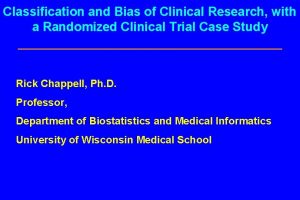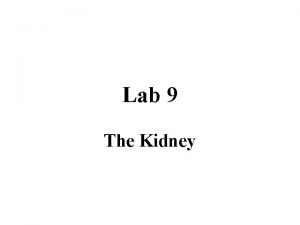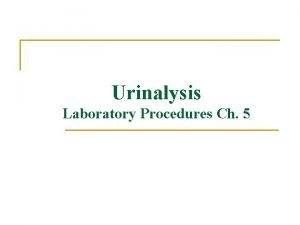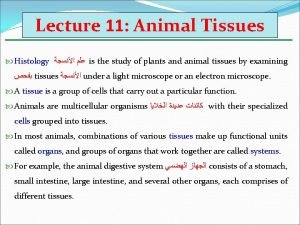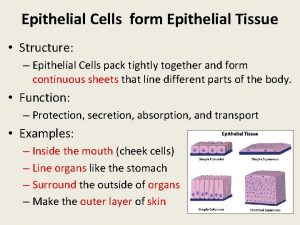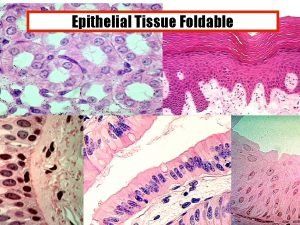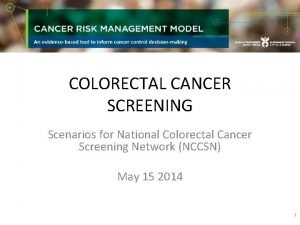COLORECTAL CANCER Colorectal Cancer arises in Epithelial cells











- Slides: 11

COLORECTAL CANCER Colorectal Cancer arises in Epithelial cells outlining the lumen of Colon & Rectum. Epidemiology: u u Cancer is the 3 rd cause of ww. (6, 3 million D/Y). About 876, 000 get CRC/Y. About 525 000 CRC, D/Y. Incidence Rate=15/ 100 000. u CRC u is the 3 rd cancer killer after: 1 Lung Cancer > 2 Stomach. death

COLORECTAL CANCER u COLORECTAL u u Abnormal growths protruding into the large intestine. Common condition in 20% of adults. Most polyps are benign. They produce no symptoms. u SYMPTOMS u u u POLYPS: OF CRC: Rectal Bleeding. Change Of Bowel Habits. Abdominal Pain, Discomfort. Decreased Stool Diameter. Weight Loss.

COLORECTAL CANCER u How Are Polyps Diagnosed? u Colorectal Endoscopy: u 1. Colonoscopy. u 2. Sigmoidoscopy. u Barium enema x-ray techniq. u Fecal Occult Blood Test. (FOBT) Removal of polyps is advised. u Colostomy is performed for late stages. u

COLON CANCER u As a result of accumulation of genetic alterations a polyp (adenoma) is formed which turns into a cancer. u A progression from early to intermediate to late adenoma to a carcinoma.

Staging System Characteristics 1: Degree of penetration in the bowel wall. u 2: L. N. involvement. u u 3: Distant metastases. Involvement Liver Metastases L. N. Kidney Metastases

STAGING SYSTEM OF C. C. u u u u Astler-Coller: A: Tumor limited to mucosa, B 1: Tumor grows through muscularis mucosae, B 2: Tumor grows beyond muscularis propria, C 1: Stage B 1 with regional L. N. metastases, C 2: Stage B 2 with regional L. N. metastases, D: Distant metastases.

GRADING SYSTEM OF C. C. u. Grading: u Normal cells (differentiated) u Cancer (less differentiated). differentiation Faster growth & metastases. u G 1: Well differentiated, u G 2: Moderately well differentiated, u G 3: Poorly differentiated, u G 4: Undifferentiated. u Less

THE CELL CYCLE

COLON CANCER u P 53 u u gene : (TSG) Located in the S. A. of chromosome 17. Code for phosphoprotein that functions as T. F. In respond to DNA damage P 53 protein expression is increased, And regulates the transcription of genes that induce cell cycle arrest or apoptotic cell death. P 53 mutation occurs in 80 -90% of sporadic C. C.

COLON CANCER u Adenom. Polypopsi Coli (APC) gene: u Located on L. A. of chromosome 5. u APC protein plays a role in: u u regulation of apoptatic cell death; Transfection of normal APC gene into cell lines having 2 mutant APC genes induces apoptosis. Mutations on it occur on 50 -80% sporadic colonic adenoma. of

COLON CANCER u. H 19 Gene: An imprinted & developmentally regulated gene. u Its product remains untranslated (oncofetal m. RNA). u Expressed in tumors arising from tissues, which express it in the fetal life. u Located on chromosome 11 p 15. 5 u To date, its function remains unknown. u


